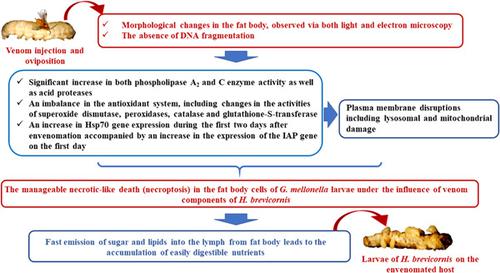当前位置:
X-MOL 学术
›
Arch. Insect Biochem. Physiol.
›
论文详情
Our official English website, www.x-mol.net, welcomes your
feedback! (Note: you will need to create a separate account there.)
Galleria mellonella larvae fat body disruption (Lepidoptera: Pyralidae) caused by the venom of Habrobracon brevicornis (Hymenoptera: Braconidae)
Archives of Insect Biochemistry and Physiology ( IF 1.5 ) Pub Date : 2020-10-07 , DOI: 10.1002/arch.21746 Natalia A. Kryukova 1 , Ksenia A. Mozhaytseva 1 , Ulyana N. Rotskaya 1 , Viktor V. Glupov 1
Archives of Insect Biochemistry and Physiology ( IF 1.5 ) Pub Date : 2020-10-07 , DOI: 10.1002/arch.21746 Natalia A. Kryukova 1 , Ksenia A. Mozhaytseva 1 , Ulyana N. Rotskaya 1 , Viktor V. Glupov 1
Affiliation

|
The ability of Habrobracon brevicornis venom to elevate the nutritional suitability of a host by affecting the host larvae fat body condition was studied. To understand whether H. brevicornis crude venom impacts the host biochemical profile, the concentrations of total lipids and main sugars in the host larvae lymph were analyzed. All measurements were carried out during the first 3 days after envenomation. A significant increase in the lipid level was fixed only on the second day after envenomation. A significant increase in the total trehalose count was detected during all 3 days, while a significant increase in glucose concentration was noted only on the first day. Well‐observed disruptions were fixed in thin and semithin sections of the G. mellonella larval fat body starting from the second day after envenomation. Significant increases in both phospholipase A2 and C enzyme activity as well as acid proteases were detected in the wax moth fat body after envenomation during all experimental times. At the same time, imbalances in the antioxidant system, including changes in the activities of superoxide dismutase, peroxidases, catalase, and glutathione‐S‐transferase, were detected. The reliable increase in the expression of the gene encoding Hsp70 was fixed both for 24 and 48 h after envenomation, while a reliable increase in the expression of the gene encoding inhibitor of apoptosis protein was detected only 24 h after wax moth larvae envenomation. Considering the absence of DNA fragmentation, the imbalance in the “ROS/antioxidants” system, and the increased activity of phospholipases and acid proteases in the fat body cells from envenomated wax moth larvae, we can hypothesize that the fat body disruption occurs in a necrotic manner. The results of the work expand the knowledge about the biochemical aspects of interaction between ectoparasitoids and their hosts
中文翻译:

短小Habrobracon brevicornis(膜翅目:Braconidae)的毒液引起的Malleria mellonella幼虫脂肪体破坏(鳞翅目:y科)
研究了Habrobracon brevicornis毒液通过影响宿主幼虫脂肪体状况来提高宿主营养适应性的能力。为了了解短螺旋体粗毒液是否影响宿主的生化特性,分析了宿主幼虫淋巴中的总脂质和主要糖的浓度。所有的测量都在麻醉后的前三天内进行。仅在麻醉后第二天,血脂水平明显增加。在所有3天中检测到的总海藻糖计数均显着增加,而仅在第一天才发现葡萄糖浓度显着增加。公观测中断分别固定在薄和半薄切片蜡螟幼虫脂肪体从毒液第二天开始。两种磷脂酶A 2均显着增加在所有实验时间内,毒化后在蜡蛾脂肪体内均检测到了C,C和C酶活性以及酸性蛋白酶。同时,检测到抗氧化剂系统的失衡,包括超氧化物歧化酶,过氧化物酶,过氧化氢酶和谷胱甘肽-S-转移酶活性的变化。毒化后24和48小时固定编码Hsp70的基因的可靠增加,而蜡蛾幼虫毒化仅在24小时检测到编码凋亡蛋白抑制剂的基因的可靠增加。考虑到DNA片段的缺失,“ ROS /抗氧化剂”系统的不平衡以及毒化蜡蛾幼虫在脂肪体细胞中磷脂酶和酸性蛋白酶的活性增加,我们可以假设脂肪的破坏以坏死的方式发生。这项工作的结果扩大了关于类异寄生虫及其宿主之间相互作用的生化方面的知识。
更新日期:2020-10-07
中文翻译:

短小Habrobracon brevicornis(膜翅目:Braconidae)的毒液引起的Malleria mellonella幼虫脂肪体破坏(鳞翅目:y科)
研究了Habrobracon brevicornis毒液通过影响宿主幼虫脂肪体状况来提高宿主营养适应性的能力。为了了解短螺旋体粗毒液是否影响宿主的生化特性,分析了宿主幼虫淋巴中的总脂质和主要糖的浓度。所有的测量都在麻醉后的前三天内进行。仅在麻醉后第二天,血脂水平明显增加。在所有3天中检测到的总海藻糖计数均显着增加,而仅在第一天才发现葡萄糖浓度显着增加。公观测中断分别固定在薄和半薄切片蜡螟幼虫脂肪体从毒液第二天开始。两种磷脂酶A 2均显着增加在所有实验时间内,毒化后在蜡蛾脂肪体内均检测到了C,C和C酶活性以及酸性蛋白酶。同时,检测到抗氧化剂系统的失衡,包括超氧化物歧化酶,过氧化物酶,过氧化氢酶和谷胱甘肽-S-转移酶活性的变化。毒化后24和48小时固定编码Hsp70的基因的可靠增加,而蜡蛾幼虫毒化仅在24小时检测到编码凋亡蛋白抑制剂的基因的可靠增加。考虑到DNA片段的缺失,“ ROS /抗氧化剂”系统的不平衡以及毒化蜡蛾幼虫在脂肪体细胞中磷脂酶和酸性蛋白酶的活性增加,我们可以假设脂肪的破坏以坏死的方式发生。这项工作的结果扩大了关于类异寄生虫及其宿主之间相互作用的生化方面的知识。











































 京公网安备 11010802027423号
京公网安备 11010802027423号